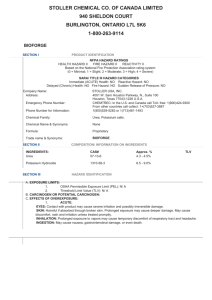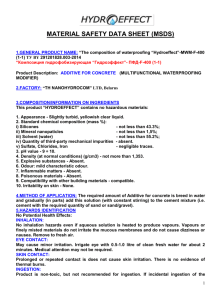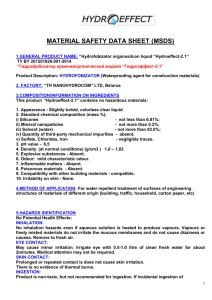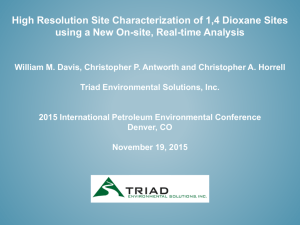safety data sheet - SIBUR International GmbH
advertisement
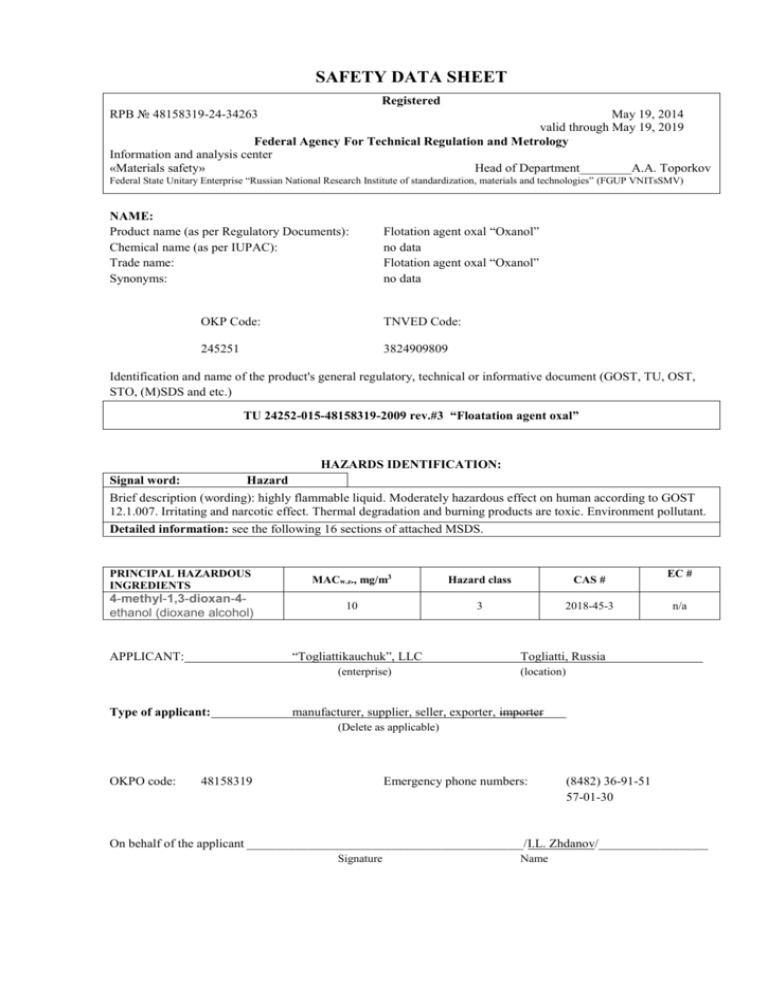
SAFETY DATA SHEET Registered RPB № 48158319-24-34263 May 19, 2014 valid through May 19, 2019 Federal Agency For Technical Regulation and Metrology Information and analysis center «Materials safety» Head of Department________A.A. Toporkov Federal State Unitary Enterprise “Russian National Research Institute of standardization, materials and technologies” (FGUP VNITsSMV) NAME: Product name (as per Regulatory Documents): Chemical name (as per IUPAC): Trade name: Synonyms: Flotation agent oxal “Oxanol” no data Flotation agent oxal “Oxanol” no data OKP Code: TNVED Code: 245251 3824909809 Identification and name of the product's general regulatory, technical or informative document (GOST, TU, OST, STO, (M)SDS and etc.) TU 24252-015-48158319-2009 rev.#3 “Floatation agent oxal” HAZARDS IDENTIFICATION: Signal word: Hazard Brief description (wording): highly flammable liquid. Moderately hazardous effect on human according to GOST 12.1.007. Irritating and narcotic effect. Thermal degradation and burning products are toxic. Environment pollutant. Detailed information: see the following 16 sections of attached MSDS. PRINCIPAL HAZARDOUS INGREDIENTS MACw.z., mg/m3 Hazard class CAS # 4-methyl-1,3-dioxan-4ethanol (dioxane alcohol) 10 3 2018-45-3 “Togliattikauchuk”, LLC APPLICANT: (enterprise) Type of applicant: EC # n/a Togliatti, Russia (location) manufacturer, supplier, seller, exporter, importer (Delete as applicable) OKPO code: 48158319 Emergency phone numbers: (8482) 36-91-51 57-01-30 On behalf of the applicant ___________________________________________/I.L. Zhdanov/_________________ Signature Name Terms and definitions: IUPAC – International Union of Pure and Applied Chemistry GHS – UN ST/AC.10/30 Guidelines - “Globally Harmonized System of Classification and Labeling of Chemicals” OKP – Russian Classification of Products; OKPO – Russian National Classifier of Businesses and Organizations; TNVED – Foreign Economic Activity Commodity Nomenclature; CAS# – product number in the Chemical Abstracts Service register; ЕС# - material number in the European Chemical Agency register; MACw.z. – Maximal allowable concentration in the working zone air, mg/m3 (maximal permissible dose/shift-average dose); Safety Data Sheet – applicable to: substance, mixture, material, industrial wastes. Safety Data Sheet complies with the following: - UN ST/AC.10/30 Guidelines (GHS); - “Regulation # 1907/2006 concerning Registration, Evaluation, Authorization and Restriction of Chemicals (REACH), annex II. - word: Signal One of the two words "Hazard" or "Warning!" (or “None”) shall be indicated according to GOST 31340-2007 "Labeling of chemicals. General requirements”. 1. Chemical product and company and/or vendor identification 1.1 Chemical product identification 1.1.1. Product name: Flotation agent-oxal “Oxanol” /1/ 1.1.2. Brief guidelines for use: Product is used as a component in materials used in (including restrictions for use) chemical, plaint-and-varnish and leather-shoe industries /1/ 1.1.3. Additional data: 1.2. Manufacturer or supplier: 1.2.1. Manufacturer’s full name: Limited Liability Company Togliattikauchuk. 1.2.2. Location (mailing address): Togliatti-07, POB 325, 445007 Russia 1.2.3. Tel. including emergency phone numbers: (8482) 36-93-69, 36-90-18; 36-91-51 (24h) – emergency calls 1.2.4. Fax: (8482) 70-15-18 1.2.5. E-mail: office@tltk.ru 2. Hazards identification 2.1. General exposure value: 3 hazard class as per GOST 12.1.007 (moderately (data on hazards classification as per RF laws (GOST hazardous substance) 12.1.007) and GHS (upon approval)) 2.2. Hygienic ratings of product concentration in the working zone air: No MAC w.z is established for the entire product. (MAC w.z. or Safe Reference Levels of Impact (SRLI) in the working zone) 2.3. Marking (as per GOST 31340-2007) 2.3.1. Description of hazard: 2.3.2. Hazard preventive measures: 3. Symbol – exclamation sign. Signal word: - “Warning”. Brief description of hazard: may cause sleepiness and dizziness. Skin and eye contact causes irritation. /22/ Safe handling: - Avoid inhalation of vapors; - Use only outdoors or in a well ventilated area; - Thoroughly wash hands after work; - Wear resin gloves. Accidental release measures: - If feeling unwell seek medical attention; - Inhalation: remove to fresh air and rest; - Skin contact: remove contaminated clothing and wash skin with soap and plenty of water. If irritation persists seek medical attention; - Eye contact: gently wash eyes with water for several minutes. Remove contact lenses, if appropriate, and if easy to do. Continue washing; if irritation persists, obtain medical attention; Safe storage: - keep container locked; - store in a sealed container in a properly ventilated area. /22/ Composition (information on ingredients) 3.1 Chemical name: Not available. Prescribed mix product. (as per IUPAC) 3.1.2. Formula: Not available 3.1.3. Description: Flotation agent-oxal “Oxanol” is a derivative of 4,4dimethyldioxane-1,3 synthesized from isobutylene and formaldehyde. /1/ (including range of products and indicating impurities and additives influencing product classification; method of manufacture) 3.2 Ingredients (name, CAS# and EC# (if appropriate), %wt, MACw.z. or Safe Reference Levels of Impact, hazard categories, references) Ingredients (Name, CAS#, EC#) ∑ of ingredients up to dioxane alcohols (methylpyran-dioxane), ether of 3-butanol and 4-methyl-4hydroxyethyl-1,3-dioxane and etc.) (CAS- n/a; EC – n/a) Dioxane alcohols (CAS- 2018-45-3; EC – n/a) Heavy hydrocarbons (diols, triols, mixed formals of methanol and dioxane alcohols, ethers and etc.) (CAS 7564-64-9; EC 231466-5) 4. % wt MACw.z. mg/m3 Hazard category 5-10 No data - 70-85 10 3 10-15 No data - References /1,3,6/ First aid measures 4.1. Symptoms: 4.1.1. Inhalation (breathing): 4.1.2. Skin contact: 4.1.3. 4.1.4. Eyes contact: By mouth (swallowing): 4.2 First aid measures: 4.2.1. Inhalation: 4.2.2. Skin contact: 4.2.3. Eye contact: 4.2.4. By mouth: 4.2.5. Contra-indications: 4.2.6. First-aid equipment (first-aid kit) 5. Fire-fighting measures 5.1. Description of fire and explosion hazard: 5.2. Fire/explosion hazards: (classification as per GOST 12.1.044 and GOST P 51330.0) Cough, throat irritation, pneopneic reflex (dioxane alcohol) /25/ Irritation (dioxane alcohol) /25, 26/ Irritation (dioxane alcohol) /25, 26/ Motor excitement followed by apathy, sleepiness, motor dysfunction, slow breath, anesthesia /25/ Remove to fresh air, leave to rest in a warm place; Remove tight clothing; give soothing and sedative medicines. If the injured person has lost consciousness ensure horizontal body position with head a little down. Give ammonia inhalant (with a cotton wool tampon). If doesn’t breathe perform mouth-to-mouth resuscitation (first free the victim’s mouth from mucus and vomit masses), continue until the person can breathe by himself. Immediately seek medical attention. /1, 3, 25/ Flush with running water with soap /1, 25/ In contact with hot product, immediately put down the injured skin area in water or wash with plenty of water to remove heat, apply an antiseptic dressing, seek medical attention, if required. /23/ Immediately flush with plenty of water, consult an ophthalmologist, if appropriate. /1, 25/ Give plenty of water to drink, give charcoal, saline purge. Seek medical attention. /23, 25/ No /1, 25/ A first-aid kit complete with antiseptic dressings, ammonia inhalant, soothing and sedative drugs shall be stored at the manufacturer’s or user’s workplace. /3/ Combustible. Flammable if exposed to open fire. IIA-T3 category of explosive mixtures. /1, 3, 11, 13/ Flash point, at least 120º C Self-ignition point: 272º C Flammability range: Lower: 30.6% vol. Upper: 51.0% vol. /1, 3/ Dioxane alcohol: Flash point: 130º C Self-ignition point: 272º C 5.3. Combustion gases and/or thermal degradation hazards: 5.4. Recommended extinguishing agents: - Small fire - Large fire 5.5. Prohibited extinguishing agents 5.6. Personal fire-protective equipment: (PPE used by fire fighters) 5.7. Advice for fire-fighters /25/ When burning, oxanol (dioxane alcohol) produces carbon oxides /25/ Large concentrations of carbon dioxide in the air cause narcotic effect, headache and irritation of mucous membranes. High concentration of carbon dioxide is caused by reduced oxygen content in the air which results in suffocation due to the lack of oxygen. Products of incomplete combustion contain carbon monoxide which is a strong poison. Acute intoxication is characterized by convulsions, dyspnoea, loss of consciousness and suffocation. MACw.z. for carbon oxide – 20 mg/m3 MACw.z. CO2 – 27000/9000 mg/m3 /6/ Foam, dry powder and CO2 extinguishers, sand, fire blankets, asbestos cloth. /1,3/ Water mist, chemical and air-filled foam. /1, 3, 23/ No data /1,3/ For emergency brigades – impermeable protective suit complete with a self-rescuer (SPI-20). /23/ Enter the emergency zone only in a protective suit and breathing apparatus. Stay away from the containers and tanks. Use water mist and air-filled foam to extinguish the fire staying away from the fire area. Cool down the containers (tanks) using water and staying at a maximal distance from them. /23/ 6. Accidental release measures 6.1. Measures to prevent harmful effect on people, environment, buildings, structures and etc. during accidental release 6.1.1. General precautions: Separate the danger zone within a radius of at least 50 m. Correct said distance upon results of chemical detection. Take away all unauthorized personnel. Strictly follow fire safety rules. Do not smoke. Remove all sources of sparks and fire. Enter the danger zone only in protective suits. Provide first medical aid to injured persons. Take the injured persons to a hospital. /23/ 6.1.2. Personal protection equipment Use an all-service protective suit (L-1 or L-2) complete (emergency brigades and personnel) with commercial respirator with canister of B or A type. In case of ignition use an impermeable protective suit complete with a self-rescuer (SPI-20). /23/ 6.2. Accidental release procedures 6.2.1. Steps to be taken if material is released or Call local Gas Safety Service. Inform the State Sanitary spilled: and Epidemiologic Supervision Service (including precautions to be taken for environment protection) (Gosepidnadzor). Do not touch the spill. Surround the spill area with a dike. Pump out the spilled material into a proper container or a drain tank taking care not to stir the liquids. 6.2.2. 7. Fire-fighting measures: Cover the spill area with sand. Remove the contaminated surface ground, collect and send for disposal. Backfill the removed ground area with new soil. /23/ In case of spills in confined areas (premises) immediately cut off the power outdoors, cover the spill area with sand and remove contaminated sand with a scoop or a shovel made of a sparkless material, wash the spill area with water. /1,3/ When all accidental release procedures are over measure MAC of hydrocarbons, dioxane alcohol and carbon oxide. /3/ Call a fire brigade; take all unauthorized personnel away from the site. Before the fire brigade arrives start extinguishing with emergency fire-fighting equipment (asbestos cloth, foam and carbon-dioxide extinguishers), as specified in Section 5 above. /3/ Fire brigade shall keep away from the tanks. Cool down the tanks using water at a maximal distance. /23/ Handling and storage of chemicals 7.1. Precautions to be taken in handling 7.1.1. Safety measures and collective protection equipment (incl. fire-fighting measures): 7.1.2. Environment protection measures: 7.1.3. Safety handling and transportation: 7.2. Storage of chemicals: 7.2.1. Conditions and periods of safe storage: (including guaranteed storage life) 7.2.2. Incompatibility: 7.2.3. Transport and consumer packaging: 7.3. Safety rules and storage precautions in household use: 8. Exposure controls/Personal protection 8.1. Working zone parameters subject to constant monitoring (MAC w.z. or Safe Reference Levels of Impact in the working zone): All equipment and utility lines shall be sealed and earthed; all working areas shall be properly ventilated; exhaust hoods shall be provided locally. Sound signaling and light warning systems shall include: pre-explosion detectors, level alarms. /1,3/ Use personal protection means. See Section 8 of MSDS. Avoid inhalation, eye contact, ingestion, skin contact. Provide regular safety briefings, compliance with process safety rules, medical aid training. /3/ Environmental protection during the product manufacture, transportation, storage and use is provided due to sealing of all process equipment and tanks, prevention of products discharge into the air, ground, water bodies and sewage drains. /3/ The product shall be transported complying with the rules of transportation of dangerous goods. /1, 24, 27/ See Section 14 of MSDS. Filling ratio for the tanks and shipper containers: 0.8 /3/ The product shall be stored in tightly closed containers under a nitrogen blanket at an ambient air temperature away from open flame. Storage life is 1 year from the manufacture date. /1,3/ Oxidizers, acids, alkali (for dioxane alcohol) /25/ Carbon steel /3/ Not applicable. /1/ Maximal allowable concentration of saturated hydrocarbons C2-C10 and dioxane alcohol in the air of working zone shall be controlled complying with methods approved by the health authorities: MACw.z., mg/m3: saturated hydrocarbons C2-C10 – 900/300 dioxane alcohol – 10 8.2. Ensuring permissible concentrations of harmful substances: Personnel protection equipment: 8.3.1. General recommendations: 8.3.2. Respiratory protection (types of RPE): 8.3.3. Protective clothing (material, type): 8.3.4. 9. RPE in household use: Physical/chemical properties 9.1. Physical state: (state of aggregation, color, odor) /1, 3, 7/ All equipment and utility lines shall be sealed and earthed; all working areas shall be properly ventilated; exhaust hoods shall be provided locally. Sound signaling and light warning systems shall include: pre-explosion detectors, level alarms. /1,3/ All workers shall complete safety trainings as per GOST 12.0.004-90. The workers engaged in manufacture and use of the product shall wear overalls and protective boots according to the approved procedures as per GOST 12.4.130-83 and GOST 12.4.011-89 and branch standards for free overalls and protective boots and other personal protective means provided to all workers and technicians as approved in accordance with the established procedure. All personnel involved in manufacture and application of the flotation agent-oxal shall undergo health examinations prior to employment and after on a regular basis. /1, 3/ In case of exceeding maximal allowable concentrations of the product in the working zone air filter respirators of A, BKF types shall be used. /1, 13/ When working inside the tanks and vessels use airline respirators of PSH-1, PSH-2 type, oxygen-breathing apparatus. /3/ Use cotton overalls of “B” type protecting against industrial soiling, leather boots as per GOST 12.4.111, GOST 12.4.112, GOST 12.4.137. /16, 17, 18/ Protective goggles “3NCH” as per GOST 12.013. /15/ Prior to work apply fatty cream; use skin cleansers (cleaning agents) after work and before taking meals. /3/ Wear union fabric gloves as per GOST 12.4.010 to protect hands against mechanical impacts. /14/ Not applicable /1/ Fluid with no color or light-yellow, light-green color with aromatic odor. /1,3/ 9.2. Basic chemical properties, mainly those relating to hazardous properties: (temperature, pH, solubility, n-octanol/water (LogKow) ratio and etc.) Density, g/cm3 Solubility in water at 20º C Solubility in fats and oils Bubble point, º C, not less than Open-cup flash point, º C, not less than Self-ignition temperature, º C Flammability range, % vol. 1.06 – 1.1 Soluble (dioxane alcohol) Insoluble 225 120 272 /1, 3/ /25/ /25/ lower upper 10. Stability and reactivity data 10.1. Chemical stability: (indicate decomposition products of unstable materials) 10.2. Reactivity: 10.3. Conditions to avoid: (incl. hazards under contact with incompatible substances and materials) 11. Toxicological information 11.1. Description of exposure (level of hazard (toxicity)) 11.2. Exposure routes: (inhalation, oral, skin and eye contact) 11.3. Target human organs, tissues and systems: 11.4. Health hazards in case of direct contact, as well as possible adverse effects (irritation of upper respiratory tract, eyes, skin, including absorption through skin, sensibilization): 11.5. Long-term effects: (reproductive hazard, carcinogenic activity, cumulative effect and etc.) 11.6. Acute toxicity (DL50 , exposure routes (oral, dermal), type of animal; CL50, time of exposure (h), type of animal) 11.7. Minimal toxicity doses (concentrations): 30.6 51.0 Flotation agent-oxal is stable under normal conditions. /3/ Hydrolyzing, oxidizing, hydrogenising material; generates ethers and salts (for dioxane alcohol) /25/ Avoid heating. /1,3/ Hazardous products of thermal degradation: Carbon oxides. See Section 5 above. Incompatible with the following products: Oxidizers, acids, alkali (for dioxane alcohol). /25/ Acute toxicity: Ingestion – 3d hazard category - moderately hazard substance (moderately toxic) Inhalation – 4th hazard category – low hazard substance (low toxic). Under high temperature the evolved dioxane alcohol causes narcotic effect, headache, apathy, motor dysfunction, cough, throat irritation, slow motions, pneopneic reflex. /8,25/ In case of fire carbon oxides may be toxic. /23/ Skin and eye contact, inhalation, ingestion. /3, 25/ No data for the entire product. Dioxane alcohol: Central nervous system, upper respiratory tract, liver, kidneys, skin, eyes. /25/ In case of a fire burns and injuries are possible. /23/ Flotation agent-oxal “Oxanol” is skin and eye irritant. No sensitizing and percutaneous action is known. /1/ Dioxane alcohol irritates upper respiratory tract, mucous membranes and skin, may be absorbed through skin. Sensitizing action was not studied. /25/ Species and sex sensitivity is unknown. Low cumulative effect. /1/ Dioxane alcohol has embryotrophic, gonadotrophic and low cumulative effects. Teratogenic, mutogenous and carcinogenic effect of dioxane alcohol has not been studied. /25/ DL50 – 2700 mg/kg, intragastric – female rats CL50 mg/m3 Exposure time, h Type of animals Not reached 2 mice /3, 26/ Flotation agent-oxal “Oxanol” – no data; Dioxane alcohol: MNDchr – 0.002 mg/kg, intragastric, 6 months, rats; ED – 325 mg/kg, intragastric, 30 days, rabbits (kidney channel disorders, high glucuronides content in urine). /25/ 12. Ecological information 12.1. Brief description of environmental impact: Flotation agent-oxal (Oxanol) may be harmful for (atmosphere, water bodies, soil) 12.2. Exposure pathways: 12.3. Impact indicators: biological objects if discharged into air, water bodies and soil. /3/ Failure to comply with storage, handling and transportation regulations may lead to accidental release of the product and its entering the water bodies, air and soil. /3/ Flotation agent-oxal (Oxanol) imparts odor and taste to water. Changes the odor of ambient air (because of dioxane alcohol). /5, 7, 28/ 12.4 Major environment impact indicators: 12.4.1.Hygienic standards: (allowable concentrations in the atmospheric air, water, incl. fishery stations, soil) MACatm or MACwater2 or SRLIatm., APLwater, mg/l, Ingredients mg/m3 (LNV1, (LNV, hazard hazard category) category) 0.01 (SRLI) 0.04 s.-t. Dioxane alcohol No II No 12.4.2. Ecotoxicological information: (CL, EC for fish, daphnia Magna, algae and etc.) 12.4.3. Environmental fate and pathways (oxidation, hydrolytic degradation and etc.) 13. Disposal considerations 13.1 Safety Precautions to be taken in handling of wastes resulted from usage, storage, transportation and etc. 13.2. Information on the sites and methods for deactivation, disposal or management of the material, including containers (packaging): MACfish.st3 or SRLIfish.st, mg/l, (LNV, hazard category) MAC or APC for soil, mg/kg (LNV) Information sources N/D N/D /2, 5, 7, 29/ No data for the flotation agent-oxal (Oxanol) and dioxane alcohol. /1, 25/ Dioxane alcohol as a component of the flotation agentoxal may migrate into air. Dioxane alcohol is transformed into 4-Methyl-1,3dioxane-4al. /25/ No wastes are resulting from oxanol manufacture. In case of product leakage during production, storage and transportation, act as described in Section 6 paragraph 6.2.1 of this MSDS. /1,3,23/ All liquid wastes collected during an accidental release shall be burnt in the manufacturing-plant’s furnaces. The wastes, resulted from leakage during transportation, are to be taken away to the industrial waste landfill or to a dedicated site as approved by the local Sanitary and Epidemiological Supervision Authorities and burnt. All solid wastes – cloth, sand impregnated with product are to be taken away to an industrial waste landfill and disposed. /1,3.23/ 13.3. Disposal of household wastes: 1 Not applicable. LNV – limiting nuisance value (tox. – toxicological; s.-t. – sanitary-toxicological; org.- organoleptic; refl. – reflexory; res.- resorptive; refl.-res. – reflexory-resorptive; fish.st. – fishery station (change of market quality of commercially exploited species); gen. – general sanitary); 2 Water of drinking and household water bodies, amenity needs water bodies 3 Water of fishery stations (including marine fishery stations) 14. Transportation information 14.1. UN number: None (as per UN regulations on transportation of dangerous goods (UN model regulations), last revision) 14.2. Proper shipping name and/or transportation name: Flotation agent «Oxal». Flotation agent –oxal «Oxanol». /1,33/ 14.3. Transport: Railway cars (tanks), motor vehicles (boiler trucks). 14.4. Hazards classification: Class 9 Classification code М6 Hazard code 90 Hazard label according to the sample No. 9 /1/ (as per GOST 19433 and UN regulations on transportation of dangerous goods) 14.5. Hazard label: (handling signs; basic, additional and informative records) /1,20/ Hazard label with manipulation sign «Protect from direct sunlight», (see drawing 2) as per GOST 1510 on each cargo item. Special patterns on tanks: «Oxal», «X». /33/ 14.6. Packaging group: (as per UN regulations on transportation of dangerous goods) 14.7. Road transportation hazards: 14.8. Transport emergency cards: Not regulated. /24/ Since April 2012 instead of national road transportation rules, including KEM (emergency measures code), ADR rules are used. 902 (railway, marine and other type of transportation) Class 9 14.9. International traffic hazards: (as per SMGS, ADR, RID, IMDG Code, ICAO/IATA and Classification code М6 other, including information on environmental risks, including “marine pollutants”). /24,27/ 15. Regulatory information 15.1. Local laws 15.1.1. RF laws: 15.1.2. Human and environment protection regulatory documents: (certificates, hygiene certificates, records and etc.) «Law on Technical Regulation», « On Protection of Environment», «On sanitary and epidemiologic well-being of population». «On Occupational Safety and Health in RF». TU 2452-015-48158319-2009 rev. No. 3 «Flotation agent-oxal» 15.2. International laws 15.2.1. International Conventions and Agreements: (Montreal Protocol, Stockholm Convention and etc.) 15.2.2. EC hazard labeling (hazard pictograms, risk and safety phrases and etc.) 16. Additional information 16.1. Data on MSDS revision (new edition): (“MSDS is newly introduced” or otherwise, indicating the reason for MSDS revision) The product is not regulated by Montreal Protocol, Stockholm Convention. /31,32/ Hazard label is absent. /24.26/ R and S-phrases: R 36/37/38 Irritating for eyes, respiratory tract and skin. S 26 Eye contact: immediately wash with plenty of water and seek medical attention. S 28 Skin contact: immediately wash with plenty of water. /26/ Material Safety Data Sheet was revised instead of MSDS No.48158319.24.20940 dd. May 14, 2009 complying with GOST 30333-2007. 16.2. List of references 1. TU 2452-015-48158319-2009 as rev. No. 3 «Flotation agent-oxal» 2. “Hygienic standards of chemical substances in the environment” edited by V.V. Semenova. Saint-Petersburg, «Professional». 2005. 3. Process regulations for production of 4.4 dimethyl 1.3-dioxane from isobutylene and formaldehyde, LLC «Togliattikauchuk». 4. “Fire and explosive substances and materials and relative extinguishing equipment” edited by A. Y. Korolchenko. Moscow. Association «Pozhnauka» 2004. 5. Maximum allowable concentrations (MAC) of contaminants in the community air. Hygienic standards HS 2.1.6.1338-03. Ministry of Health of the Russian Federation. Moscow 2003. 6. Maximum allowable concentrations (MAC) of contaminants in the working area air. Hygienic standards HS 2.2.5.1313-03. Ministry of Health of the Russian Federation. Moscow 2003. 7. Maximum allowable concentrations (MAC) of contaminants in drinking and household water bodies, amenity needs water bodies. Hygienic standards HS 2.1.5.1315-03. Ministry of Health of the Russian Federation, Moscow 2003. 8. Harmful substances in the manufacturing industry. Reference book for chemists, engineers and doctors, volumes 2,3. Edited by N.V. Lazarev, publisher Chemistry, Leningrad 1971. 9. GOST 1510-84 Crude oil and refined products. Marking, packing, transportation and storage. 10. GOST 12.1.007-76 Occupational safety standards system. Harmful substances. Classification and safety general requirements. 11. GOST 12.1.044-89 Occupational safety standards system. Fire and explosion hazard of substances and materials. The list of parameters and its determination procedures. 12. GOST 12.4.007-76 Occupational safety standards system. Respiratory protective equipment. 13. GOST Р 51330.19-99 Occupational safety standards system. Explosion protected electrical facilities. Part 20. The data on inflammable gases and vapors, related to equipment operations. 14. GOST 12.4.010-75 Occupational safety standards system. Personal protection equipment. Special gloves. 15. GOST 12.4.013-85 Occupational safety standards system. Protection glasses. General technical specifications. 16. GOST 12.4.111-82 Occupational safety standards system. Man suits for protection from crude oil and refinery products. Technical specifications. 17. GOST 12.4.112-82 Occupational safety standards system. Woman suits for protection from crude oil and refinery products. Technical specifications. 18. GOST 12.4.137-84 Occupational safety standards system. Special leather shoes to protect from crude oil and refinery products, acids, alkalis, non-toxic and explosive dust. Technical specifications. 19. GOST 19433-88 Hazardous cargos. Classification and marking. 20. GOST 14192-96 Cargo’s marking. 21. GOST Р 30333-2007 Material safety data sheet. General requirements. 22. GOST 31340-2007 Safety marking in chemical industry. General requirements. 23. Safety regulation and liquidation procedure of emergency situations with hazardous cargos while transporting it by railways. Ministry of transportation of RF. Moscow, 1997. 24. Agreement on International Goods Transport by Rail (SMGS). Appendix 2. Dangerous goods regulations. 25. Information card of potentially hazardous chemical and biological substance 4 methyl-1.3 dioxan-4 ethanol (dioxane alcohol). VT № 00988 dd. 04.07.96. 26. “Hazard parameters of substances and materials” edited by V.K. Gusev. Moscow. Fund named after I.D.Syteen 1999. 27. ADR. European Agreement concerning the International Carriage of Dangerous Goods by Road/UN. New-York and Geneva. 2013. 28. Water quality standards of commercial fishing importance water objects, including standards of maximum permissible concentrations in the commercial fishing importance water objects. Russian Federal Fisheries Agency Order No. 20 dd. 18.01.2010. 29. Maximum permissible concentrations (MPC) of chemical agents in the soil. Hygienic standards HS 2.1.7.204106. 30. Orange book. Standard rules. Volume 1, 15th revised edition, 2007. UN. 31. Stockholm Convention on Persistent Organic Pollutants. - UN. 2001. 32. Montreal Protocol on ozone depleters. - UN. 1989. 33. Regulations for dangerous goods transportation by railway, approved by Railroad Transportation Council of UN member countries. Protocol No.50 of April 5, 1996.

